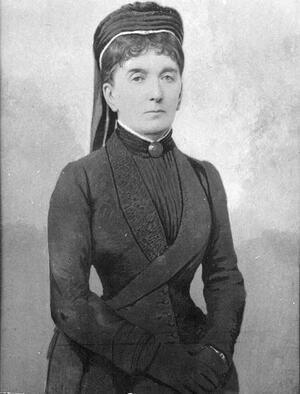Clara de Hirsch Home for Working Girls opens
As a young woman, Baroness Clara de Hirsch (née Bischoffsheim, born Antwerp, June 13, 1833; died in Paris, April 1, 1899) assisted her father in his work, becoming knowledgeable in business, legislative and philanthropic affairs. After her marriage to Baron Maurice de Hirsch in 1855, she guided his interests towards philanthropy, and specifically, towards aiding the poor, persecuted, and oppressed of his co-religionists. Designated his sole administrator, she dispensed fifteen million dollars in charity to organizations around the world after his death. Among the beneficiaries of her largesse was the Clara de Hirsch Home for Working Girls, to which the Baroness gave a total endowment of $800,000.
Institution: 92nd Street Y, New York City.
Funded by a bequest from the British Baroness Clara de Hirsch, the Clara de Hirsch Home for Working Girls opened its doors on New York's East 63rd Street on May 22, 1899. Two years in the planning, the Home was designed "to benefit working girls ... to improve their mental, moral, and physical condition, and train them for self-support." With bedrooms for 100 young women, the Home was designed to shelter both American-born and immigrant young women either working or preparing to work.
In addition to lodging, the Home provided meals, physical exercise, and classes in housework, millinery, laundry, dressmaking, and other "domestic" and "industrial" skills. Reflecting the anxieties of its time, the Home sought as much to protect the girls' morals as to ensure their physical health. The Home's initial Board of Directors, composed mostly of women of German-Jewish heritage, believed that positions as domestic servants would be safe and appropriate for their charges, and that all the girls should ultimately marry and be homemakers. Therefore, they sought to train them in the skills that would serve them well in both roles.
In addition, the Home provided educational and social opportunities. Because it was meant to serve mainly Eastern European immigrants, the Home offered English language classes as well as elementary education classes. In addition, basic Jewish religious instruction was offered for one hour a week. Outside of these classes, residents were offered literary and social clubs, access to a library, and trips to museums, parks, and concerts. Finally, the Home sponsored regular dances in an effort to keep girls away from the corrupting influence of the public dance hall.
Mirroring similar efforts by Jewish and non-Jewish clubwomen around the country, the Clara de Hirsch home combined two distinct but related aims. Supporters hoped to aid and support newcomers who might struggle to survive and thrive in the harsh urban conditions faced by immigrants. In addition, they sought to Americanize their charges and teach them a well-defined version of middle class respectability.
Over time, the Home's programs changed in response to changes in city life and the needs of New York's young women. Reacting to the imposition of immigration restriction laws and an expansion of educational opportunities for women, the Home closed its trade school in 1926, ending the classes in millinery, sewing, and other "industrial arts." In the next decade, the institution became home to rising numbers of European Jewish refugees, and also to self-supporting students. In 1960, facing a declining demand for its services, the Home merged with the 92nd Street YMHA, closing its doors on 63rd Street and contributing its assets to the building of new dormitories at the Y.
Sources:New York Times May 1, 1897, April 24, 1898, May 23, 1899, May 18, 1949; Jewish Women in America: An Historical Encyclopedia, pp. 232-234.




jUST A QUESTION : who knows all the surname of Clara de Hirsch (Bischoffsheim)and of her husband Maurice de Hirsch ? I'am looking for the surname Algire. The reason is actually a too long story for this message.
Many thanks
regards
Is there an archive list of people who stayed there?
my mom was there and made life long friends 2 are still alive. She says great things about it!
I have written about the the Clara de Hirsch home and the broader philanthropic activities of Jewish women of this era: http://mattersofeducation.org/...
My cousin lived at the Clara De Hirsch home when it became part of the 92nd street Y. She met life long friends there. Only one is still alive. But she credited the home for giving her a facility to live in as a teen ager and y oung adult because her mother had become a prostitute and she had to leave thier home in Brooklyn